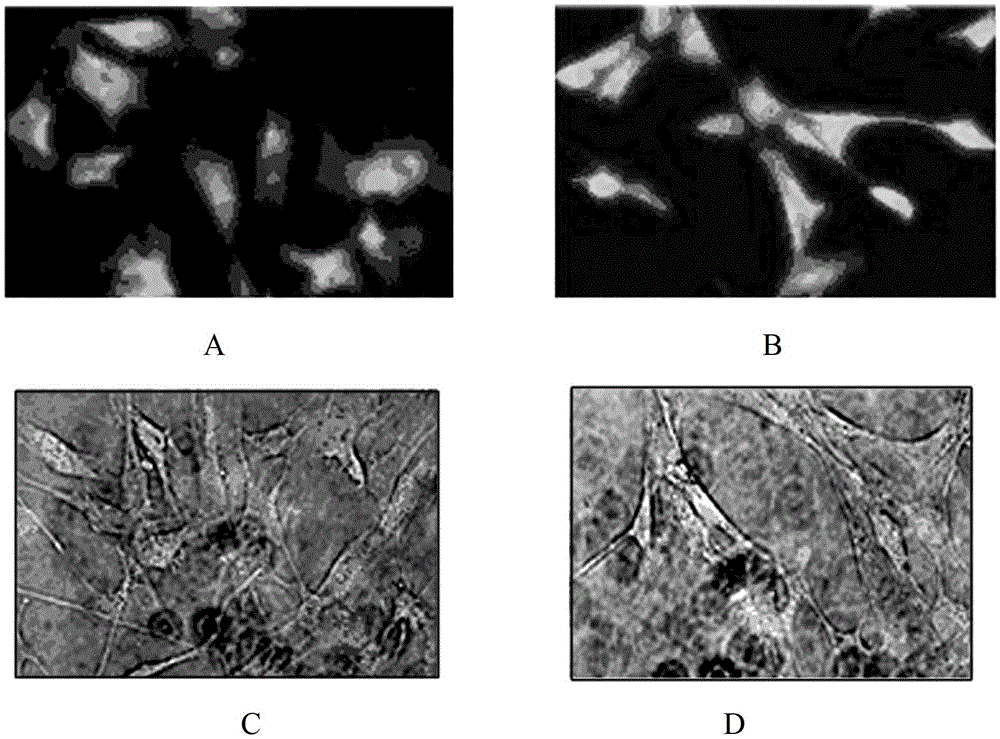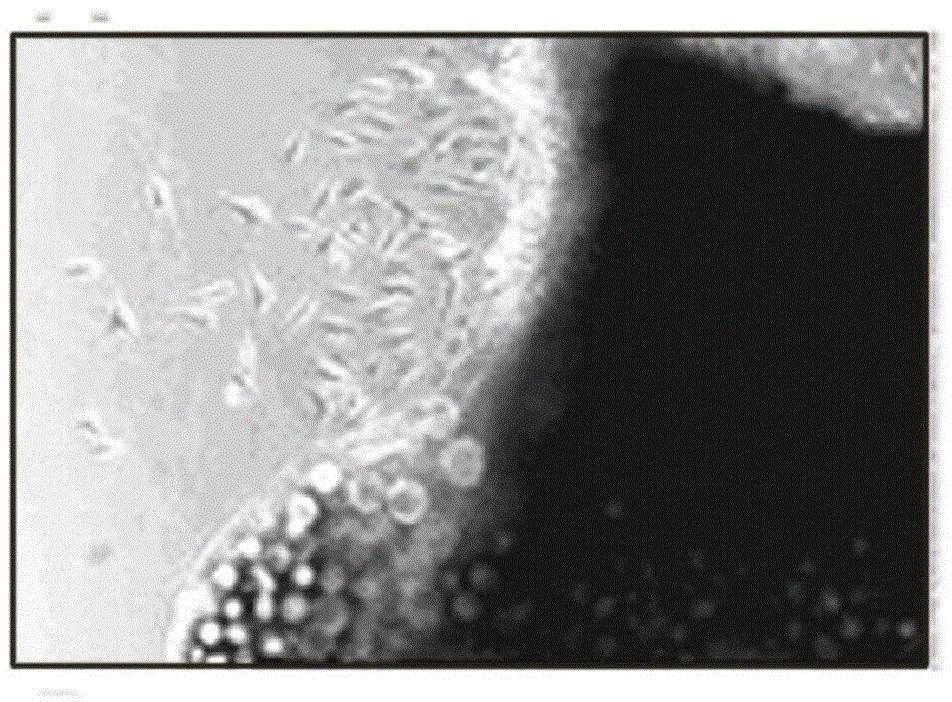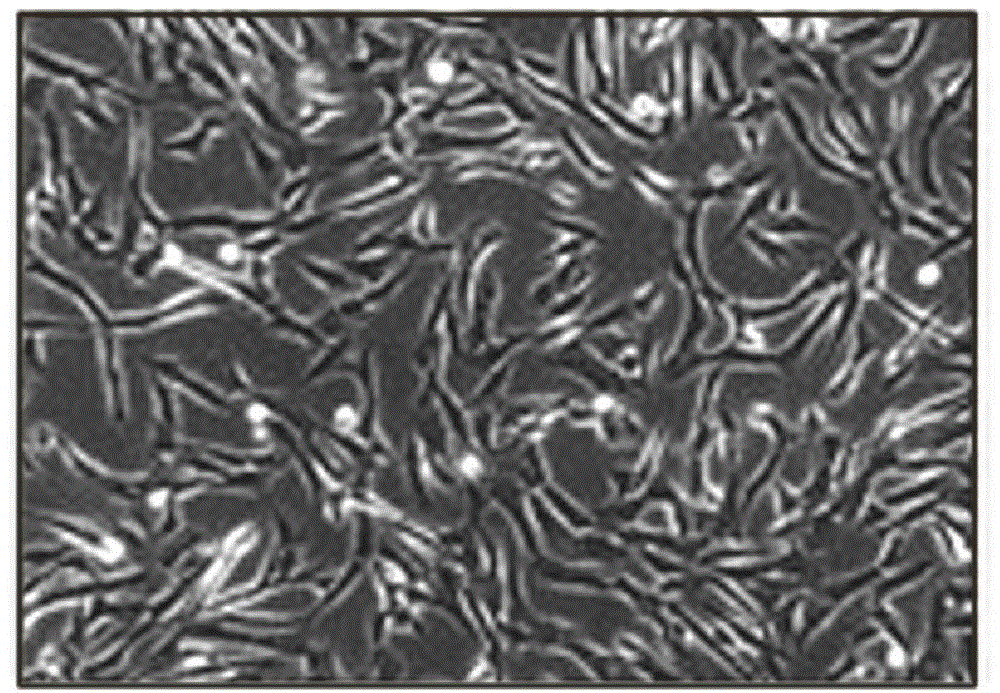Method for inducing synovium mesenchymal stem cells to be differentiated to chondrocytes by in-vitro lentivirus mediated BMP-2 (Bone Morphogenetic Protein) genes
A BMP-2, mesenchymal stem cell technology, applied in the field of biomedicine, can solve the problems of high time and cost, low success rate, etc.
- Summary
- Abstract
- Description
- Claims
- Application Information
AI Technical Summary
Problems solved by technology
Method used
Image
Examples
Embodiment 1
[0031] Embodiment 1: the acquisition, separation and identification of SMSCs
[0032] 1.1 Get SMSCs
[0033] Six 3-month-old New Zealand white rabbits (SPF grade, Slack Experimental Animal Center, Chinese Academy of Sciences, http: / / www.slaccas.com ) (average weight 2.1±0.3kg, male or female). After fixed anesthesia, a straight parapatellar incision was taken, and the joint capsule was opened layer by layer, and the suprapatellar bursa synovial tissue was harvested with tissue scissors. The obtained synovium was cut into pieces, and collagenase type 2 (0.2%, Sigma-Aldrich, Inc., http: / / www.sigmaaldrich.com ) digested for 3 hours, passed through a 200-lm filter (Jiabao Company, http: / / www.caigou.com.cn / c20931 ) to obtain tissue pieces after filtration, and cultured in 20% FBS (Hyclone company http: / / www.hyclone.com ) DMEM (GibcolBRL, http: / / www.gelcompany.com / products / gibco-brl )middle. All the above processes were carried out in the ultra-clean bench (SW-CJ-1F, Jiab...
Embodiment 2
[0052] Example 2 Vector construction and transfection
[0053] 2.1 Primer design
[0054] The GenBank number of rabbit BMP-2 is NM_0010826507, and the reading frame is 70-1257bp. Accordingly, using the SGD software ( http: / / www.yeastgenome.org / cgi-bin / web-primer ) to design primers. The primer was designed at the 5' end: 5'-CTAGCTAGCTGGAGGCTCTTTCAATGG-3' (SEQ ID NO: 1). GCTAGC is the enzyme cutting site of the restriction endonuclease Nhe1, ATG is the stop codon; 3' end:
[0055] 5'-GGGTTTACCGGTAAAGCAAAAACAAACCAA-3' (SEQ ID NO: 2). ACCGGT is the cutting site of restriction endonuclease Age1, and AAG is the stop codon.
[0056] 2.2 Amplification of BMP-2
[0057] Trizol (Gibco, http: / / zh.invitrogen.com ) to extract total RNA from rabbit liver, using 5IU MMLV (karma company, http: / / www.karmabio.cn) for the reverse transcription reaction. cDNA was synthesized after a cycle of reaction at 70°C for 5 minutes, 37°C for 60 minutes, and 95°C for 5 minutes. oBMP-2 was ampl...
Embodiment 3
[0068] SMSCs security identification after embodiment 3 transfection
[0069] 3.1 Analysis of cell proliferation kinetics
[0070] The transfected SMSCs were pressed at 50cells / cm 2 After planting in a 24-well plate, put CO 2 in the incubator. Select 3 wells every day, digest with 200 μL of 0.25% Trypsin / EDTA, and pipette repeatedly to form a single-cell suspension. The medium was not changed until all wells were taken. The number of cells in each well was counted every day and recorded as the mean value. According to the value, the growth curve is drawn according to the equation and the doubling time is calculated in turn. The equation used is TD=tlog2 / log(N / N0) (t: the time from the beginning of culture to the counted day, in hours; N: the cell count at time T; N0: the total number of cells).
[0071] Results: The number of cells for 7 days was counted, and the cell growth curve was drawn accordingly. According to the relevant formula, the cell doubling time was calcu...
PUM
 Login to View More
Login to View More Abstract
Description
Claims
Application Information
 Login to View More
Login to View More - R&D
- Intellectual Property
- Life Sciences
- Materials
- Tech Scout
- Unparalleled Data Quality
- Higher Quality Content
- 60% Fewer Hallucinations
Browse by: Latest US Patents, China's latest patents, Technical Efficacy Thesaurus, Application Domain, Technology Topic, Popular Technical Reports.
© 2025 PatSnap. All rights reserved.Legal|Privacy policy|Modern Slavery Act Transparency Statement|Sitemap|About US| Contact US: help@patsnap.com



